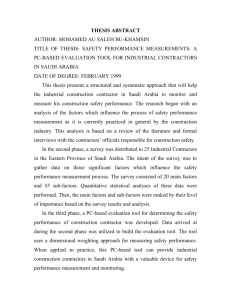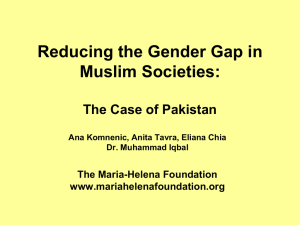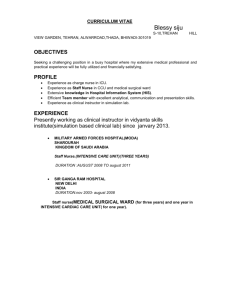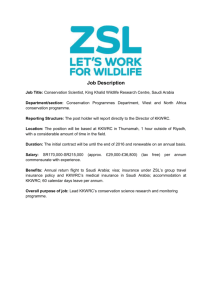Only 0.3% of the households in Saudi Arabia had no medicines
advertisement
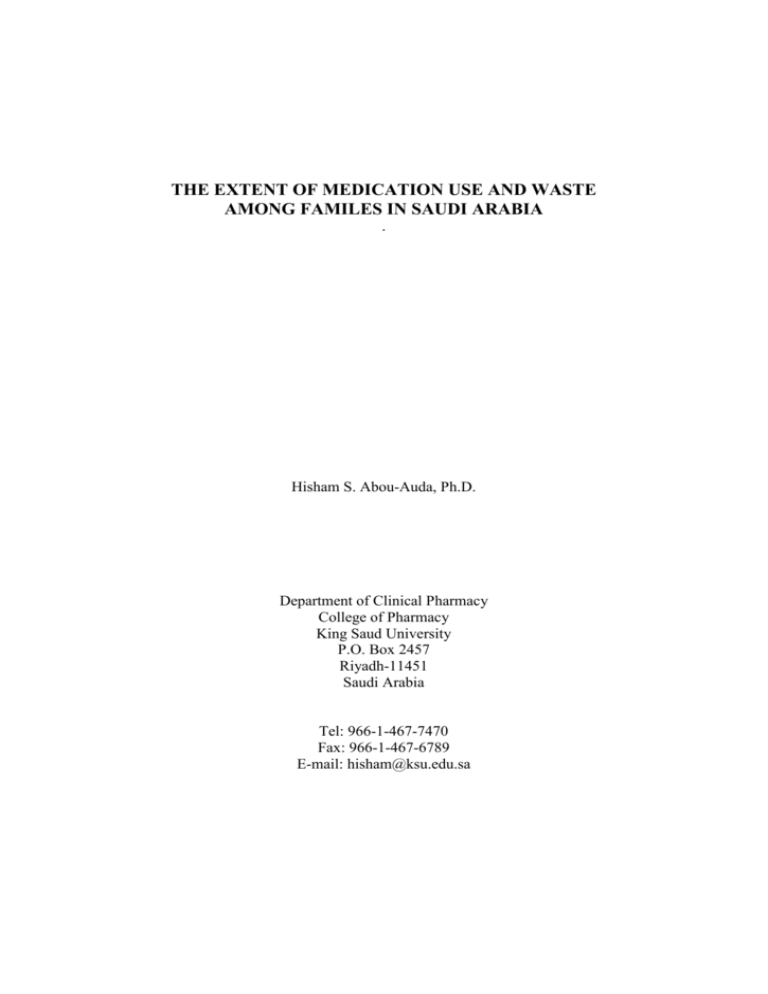
THE EXTENT OF MEDICATION USE AND WASTE AMONG FAMILES IN SAUDI ARABIA . Hisham S. Abou-Auda, Ph.D. Department of Clinical Pharmacy College of Pharmacy King Saud University P.O. Box 2457 Riyadh-11451 Saudi Arabia Tel: 966-1-467-7470 Fax: 966-1-467-6789 E-mail: hisham@ksu.edu.sa ABSTRACT Background: Expenditure for drug products and pharmaceuticals constitute a large percentage of the total expenditure on health care. In Saudi Arabia and other countries, the cost of maintaining the health care system is escalating out of control. Governments, health care providers and consumers have to find ways to reduce these escalating costs while maintaining the quality of care that these countries have grown to expect. Medication waste is an unnecessary burden on an already fiscally restrained health care system. Objective: This study has been conducted to shed some light on the extent of drug use and wastage among families in Saudi Arabia. Methods: A questionnaire was administered in 1554 households in 5 regions in Saudi Arabia. Results: The average Saudi family size was found to be 6.6±0.1 ( X SEM ). Only 0.3% of the households in Saudi Arabia had no medicines, while more than 75% of the families had 5 or more medicines and more than 25% had 10 or more medicines. The average number of medicines per household was 8.45±0.14. Respiratory (16.8%), analgesics and anti-inflammatory (16.4%) medications and antibiotics (14.3%) were the therapeutic classes of medicines of the highest frequency in these households. The average number of medicines left unused, deteriorated or expired was 2.2 per household. The medication wastage was estimated to be 25.8% based on the number of medicines expired or deteriorated, or 19.2% based on the cost of these medicines. The out-of-pocket expenditure for medication averaged 0.7% of the annual income in Saudi Arabia compared with 0.9% in the United States. Conclusion: The total dollar value of medication waste in households was estimated to be in the close vicinity of 150 million dollars a year from the budget allocated to health care. If this figure is extrapolated to the United States based on population ratio, the medication waste will exceed US$ 2 billion. There are no immediate solutions to the problem of wastage among families. The use of generic alternatives should be promoted and national pharmacovigilance systems should be implemented. Key words: Drug Consumption, Wastage, Pharmacoeconomics, Out-of-pocket expenditures, Saudi Arabia, Gulf States, Kuwait, Qatar, United Arab Emirates, Oman. 2 INTRODUCTION The cost of maintaining health care and drug costs in particular, have been escalating out of control over the past few decades. In Saudi Arabia, drugs are the fastest rising cost in the health care system and expenditure for drug products and pharmaceuticals constitutes a large percentage of the total expenditure on health care (1-2). Many nations are seeking ways to cut down budgets allocated for buying drugs. A contributing factor in the increased costs is the marketing strategies of pharmaceutical firms and the expenses incurred in producing new drug moieties. Among the major reasons behind the increased expenditure on medication is medication waste which is an unnecessary burden on an already fiscally restrained health care system in these countries (3-4). Medication wastage may be due to poor compliance of patients (5), excessive and irrational prescribing (6) or the lack of control on the sales of prescription in the community pharmacy (7). An extensive MEDLINE and IPA searches for drug or medication wastage produced very few references which are not closely relevant to the subject. The problem of wastage is almost universal. In Great Britain, the scale of the problem of wastage is enormous, research suggests that as many as 50% of the patients fail to comply with the terms of their prescription (8). A survey of 111 households was performed in England to determine the quantity and types of medicines in the homes and to investigate the incidence of double prescribing, wastage and hoarding (9). The investigators found that 51% of the medicines were not in current use by the patients and of those 40% were considered out of date. Another survey in England commissioned by a television station (10) found that each year a third of the 3 population fail to complete a course of prescribed medication. In addition, almost 25% of all adults admitted to having unused medicines in their homes. In Canada, two studies have sorted through piles of discarded medications seeking reasons why the waste of drugs is of "mammoth proportions" (3-4). The top medicines wasted regarding their dollar value were antihypertensive drugs followed by analgesics and anti-inflammatory drugs. Similar findings were obtained in drug wastage studies in Israel (11) and Algeria (12). The objectives of this study is to attempt to quantify drug use and wastage in Saudi Arabia. METHODOLOGY The study was conducted in 2001. A 6-page questionnaire was administered in 1641 families in Saudi Arabia. An adult who can understand instructions was asked to fill the first two sections of the questionnaire and answer relevant questions to the family under investigation in the presence of an investigator’s helper. The questionnaire was divided into three sections. The first section was intended to determine the demographic information pertaining to the family, including family size, number of dependents and their ages, education and profession of parents, and socioeconomic status. The second part was structured to gather data on variables such as the health status of the family, number of hospital and community pharmacy visits, attitude towards pharmacy and interaction with pharmacist, health-related expenses per year, the use of alternative medicines, self-medication, and a host of other aspects of medication use among members of the family. The third section dealt with the actual medication storage, consumption and pharmacoeconomic implications of medication use and wastage. This section involved recording and inspection of all 4 medicines and medicine containers found in the home at the time of the study. In a specially-designed form, the investigator recorded the name of the medicine, its dosage form, strength, manufacturer, manufacturing date, expiration date, original number of units (tablets, capsules, etc.) or volume, remaining or unused units, original cost and the cost of the remaining units or portions of the medicines judged by the investigator as expired or unusable based on their recorded dates or due to apparent physical or chemical deterioration. The knowledge of household members of the use of these medications and frequency of use were also recorded. The questionnaire, in its three parts, consisted of 42 questions of varied format, including checklists and open- and closed-ended questions. Families were assured anonymity and that the aggregate data will be reported. The first two sections of the questionnaire were administered in the presence of one of the assigned investigator's helpers. This ensured that the respondent understood and interpreted questions as intended and, consequently, answered them truthfully. Data Analysis Responses to each question were coded individually, and data were analyzed using the Statistical Package for Social Sciences (SPSS) for Windows© (ver. 10.0, 2000). The analysis included frequencies of discrete variables and condescriptives. Medicines were recorded and cost of the expired or unusable remaining units or portions was calculated. Medications were also classified according to their pharmacologic or therapeutic classes using the classification of drugs adopted in the Saudi National Formulary (SNF) (13). The total cost of drugs per family and the cost of drugs deemed expired or unusable per family were calculated using recorded prices on the drug packages or prices listed in SNF. Results were analyzed depending on the 5 type of data and the appropriate statistical tests were used for comparisons, e.g., independent t-test was used to compare continuous variables such as family size, number of children, annual income, cost of medication, etc. Chi-square, Fisher Exact test and Wilcoxon rank sum or Mann-Whitney U tests were used to evaluate the differences in case of discrete variables. Agreement in drug classes found in households in Saudi Arabia and Gulf States was evaluated using Kendall's tau-b and Spearman's rho. Other tests such as ANOVA and Kruskal-Wallis tests were also utilized when appropriate. If the question of data normality arose based on a probability plot, log-transformed data were used followed by a parametric test. Otherwise, one of the nonparametric alternatives would have been used. RESULTS No questionnaires were excluded from the study since all questionnaires were administered in the presence of investigator's helpers. Family medication consumption was assessed in a total of 1554 families from Saudi Arabia. Of the families surveyed, 1369 (88.1%) families were Saudi nationals and 185 (11.9%) were expatriates residing in Saudi Arabia for, at least, the last five years. Most of the work has been conducted in Riyadh metropolitan area and the central province of the kingdom with 1296 (83.4%) homes surveyed. A sample from other regions of the kingdom was obtained for comparative purposes. Due to the cost involved, only 29 (1.9%), 169 (10.9%), 31 (2.0%) and 29 (1.9%) households were surveyed in the western, eastern, northern and southern provinces of the kingdom, respectively. The demographic and socioeconomic characteristics of the families under investigation are summarized in table 1. The health expenses and number of hospital visits per year were also presented in the table. The sample for Saudi Arabia is of 6 sufficient size (power>0.9) to draw meaningful conclusions about drug consumption and wastage in this country. It was estimated that 384 families are needed to get a power of 0.8. Each family spent US$ 587.5±20 on health-related matters, whereas health expenses. These expenses represent about 2.6% of the family income in Saudi Arabia. The number of hospital visits per family is about 7 times a year in which, at least, one of the family members visits the hospital (as inpatient or outpatient) or doctor's clinic for treatment or consultation. On the other hand, there are statistically significant differences between Saudi and non-Saudi families in all of the demographic and socioeconomic characteristics except health expenses per year (Table 2). Despite the differences in annual income among these families, only 10% of the families in Saudi Arabia pay more than US$ 300/year to buy drugs from community pharmacies since most of the drug requirements of these families are furnished, at no cost, through governmental institutions. Of the 1554 families interviewed, 647 (41.6%) families refer to a governmental hospital, 552 (35.5%) to a private hospital and 301 (19.4%) to both, and consequently, get most of their needs of prescription medications from these hospitals. Hereditary or chronic diseases are major factor in drug consumption profile among families. The number of Saudi families with a hereditary disease was 291 (21.3%) compared with 29 (15.8%) for non-Saudi families residing in Saudi Arabia. The existence of a chronic disease for which, at least, one member of the family is consuming medication was also investigated. It was found that in 603 (44.1%) and 59 (32.1%) of the Saudi and non-Saudi, respectively, at least, one member of the family was suffering from a chronic disease. 7 Although drug inventory was performed on households only, the storage of drugs in glove compartment of the family car was also investigated. Some drugs are kept in the cars of 195 (14.2%) and 46 (24.9%) of Saudi and non-Saudi families, respectively, under the atmospheric conditions of heat and humidity. Overall, the study revealed that more than 80% of the families sought advice of the pharmacist in prescribing a medication for their minor ailments, and more than 20% of the families took medicines originally prescribed for their friends or relatives. In addition, more than 40% of the families bought medicines based on the advice of their friends and relatives (Table 3). These figures are a striking example of the prevalence of self medication in these societies which contributes to drug abuse and wastage. Another pronounced reason for medication wastage is the failure to completing a course of prescribed medication as admitted by 387 (24.9%) of the families in Saudi Arabia. Only 54.8% and 43.7% of the families used medication till the end of duration of use decided by their physicians in Saudi Arabia and Gulf States, respectively. Many of the drugs collected from these homes were totally unused. Although aware of the availability of expiry date of the drug, 37% of the families in Saudi Arabia indicated that they never checked the expiry date prior to drug administration (Table 3). A total of 12,463 drug products were found in 1554 households in Saudi Arabia (8.0 drugs/family) with a total retail value of US$ 81,820.9. No drugs were found in only 5 (0.32%) households, while 75.9% of the families had 5 drugs or more and 12.6% of the families had 10 drugs or more up to 35 drugs found in 3 households. Table 4 shows the distribution of the drugs found in homes of 1554 Saudi Arabian families based on drug classification adopted by the Saudi National Formulary (SNF) 8 (13) according to their pharmacological action. The largest group (16.8%) was respiratory drugs followed closely by drugs acting on the central nervous system (CNS) (16.4%) and antimicrobial agents (14.3%). Of the CNS drugs, OTC analgesics constituted about 50% of the total while sedatives, tranquilizers, antidepressants, hypnotics, anxiolytics and appetite suppressants accounted for the rest. Table 4 shows the number of drugs allocated to the 14 pharmacological classes found in homes. In any case, there was a good agreement (Kendall's tau-b=0.75, p=0.00019, and Spearman's rho=0.86, p<0.001) between medicines found in the households of Saudi Arabia and Gulf States. There was about 50% more drugs per individual in household than in Gulf States, but the percentage of expired, unused or deteriorated medicines was significantly lower (Table 5). There was no statistically significant difference in the number of medicines expired per family (2.2 and 2.7 in Saudi Arabia and Gulf, respectively). In this study, medication waste is defined as any medication that has been dispensed by a prescription or bought over the counter, and paid for by the individual or the government, but not consumed by a particular family member due to expiration or deterioration (physical or chemical) or left unused with a very slim chance of being consumed before it reaches the expiration date. According to this definition, medication waste (based on the number of drugs) was calculated to be 25.84% of the drugs in the households. Most of the families in Saudi Arabia enjoy free health care including their supply of prescription medication from governmental hospitals and primary health care clinics (1, 6, 14). Families in these countries also supplement their needs of drugs through purchase from community pharmacies. In Saudi Arabia, there are more than 3,000 community pharmacies with the largest concentration of these 9 pharmacies in Riyadh and Jeddah regions. In this study, the average annual purchase of medicines per family (out-of-pocket expenditure for medication) was calculated to be US$ 159.4 ± 4.3. Our results also indicate that these figures represent 46% of the families total annual needs of drugs and the rest is more likely to be covered by the government or health insurance companies. Out-of-pocket expenditures for medication for families have averaged 0.72%±0.02% of annual income compared with an average of 0.48%±0.05% for Gulf States (p=0.0146, t-test). Consequently, based on the population and the number of families in Saudi Arabia, drug expenditure by families surveyed in this study can be extrapolated to estimate the drug expenditure by all families in Saudi Arabia. The cost of total drug consumption by families in Saudi Arabia was calculated to be US$ 779,673,913 [about 3.0 billion Saudi Riyals (SR)], a figure in a very close agreement with the semi-official estimates of SR 4.0 billion of total drug expenditure. The discrepancy between the two figures may have been originated from the fact that the present study did not take into account hospitalbased medicines such as anesthetics, chemotherapeutic agents, etc. There was no statistically significant difference (p>0.05) with respect to cost of medication wastage between Saudi Arabia and Gulf States (Table 5). Bearing in mind the definition of wastage adopted by this study, the cost of medication waste as a result of close inspection of medicines found in households was calculated to be US$ 10.0 ± 0.6 and US$ 5.2 ± 0.6 per family in Saudi Arabia and Gulf States, respectively. Similar to the percentage of medication waste based on the number of expired medicines, medication waste based on the cost of medicines expired was statistically significant (p<0.05) between Saudi Arabia (19.2%) and Gulf (25%). Using these figures, the total dollar value of medication waste can be estimated to be in the close vicinity of 150 million dollars a year. 10 DISCUSSIONS Saudi Arabia, like many other countries around the world, has turned its public focus onto health care system, with drug expenditures and wastage drawing particular attention. This study attempted to quantify drug use and wastage in Saudi Arabia and compare the results with the corresponding figures obtained from four other Gulf States, namely, Kuwait, UAE, Qatar and Oman. The data were extrapolated to estimate the total annual cost of medication waste on a national scale especially in Saudi Arabia. One of the strength points is the prospective nature of the study where medicines were seen and their condition examined and recorded on site. Extensive literature search proved that this is the first study of its kind in this part of the world. The population in Saudi Arabia, like other populations in the Gulf region, is characterized by a high degree of cultural homogeneity and by an equally high degree of social stratification which rested in the diffusion of values and attitudes exemplified in the family. Saudi Arabian families tend to be patriarchal where the father in the family appearing to assume an authoritarian role at the top of the hierarchy. Drug culture in these families is almost identical from one individual in the family to another and from one family to another. In this regard, meeting with the father is most likely to reflect the point of view of the rest of the family members. The preponderance of drug products in these homes was clearly manifested in this study where there was, at least, one drug per individual in the family. Although most of the fathers in our sample of families are well educated, the educational level had no significant effect (p>0.05) on number of drugs found or on the amount of medication waste observed in these homes. Most of them were not aware of the proper storage conditions of their inventory of drugs and only 49.7% know the medical condition for 11 which each drug was originally prescribed. In addition, 37% in Saudi Arabia and 33.3% in Gulf States do not check the expiry date prior to drug administration. The results of overstocking medication and the abundance of expired, unused or deteriorated drugs (about 26% in Saudi Arabia and 41% in Gulf countries) as well as the absence of proper labeling or clear instructions for use may have contributed to the drug poisoning accidents observed in 6.4% and 5.7% of the families in Saudi Arabia and Gulf States, respectively. One can be almost sure that, at least, 80% of these episodes occurred in young children below the age of 5 years. It can be emphasized that more than 50% of the population are below the age of 18 years. In Saudi Arabia, family out-of-pocket expenditures for medication have averaged 0.7% of annual income compared with an average of 0.48% for Gulf States combined. Personal out-of-pocket expenditures for medication in the United States (15) have ranged from 0.8% to 1% of consumer unit income since 1985, a figure not significantly different from that of Saudi Arabia. Almost 50% of the families in Saudi Arabia and Gulf States have, at least, one chronic condition for which a drug must be consumed. The effect of the existence of a chronic condition in the family on out-ofpocket expenditures for medication was examined. Estimates based on findings of the present study suggest a strong relationship between out-of-pocket expenditures and the existence of chronic conditions. The out-of-pocket expenditures for those families with chronic conditions averaged 0.78% of the income vs. 0.67% for those with no chronic conditions (p=0.0149, t-test) in Saudi Arabia. Similarly, out-of-pocket expenditures for families with a hereditary disease averaged 0.85% vs. 0.67% for those with no hereditary disease (p=0.00184, t-test). Surprisingly, there were no statistically significant differences in out-of-pocket expenditures for medications between families with either a chronic condition or hereditary disease and families 12 without them in the Gulf States. Out-of-pocket expenditure trends indicate that drugs do not represent a large portion of the overall health care picture for families in the Gulf region. However, consumers in Saudi Arabia feel these costs more personally because large portions of outpatient drugs are purchased with out-of-pocket funds. This is may be due to the fact that citizens in the Gulf States are more dependent on their governments in supplying them with prescription and OTC medication than in Saudi Arabia. Data from the present study revealed that families in Saudi Arabia spend 16.3% more than Gulf families for out-of-pocket medications. We were cognizant that that the differences in drug expenditures may not arise from the differences in volume consumption, but from differences in drug prices in these countries. Therefore, a price comparison was carried out confirm the uniformity of drug prices in the countries of the Gulf region. It also worth mentioning that the governments of these countries through their Council of Ministers of Health resort to group tenders rather than individual direct purchase of drugs for all countries. Self medication was prevalent in Saudi Arabia and Gulf States where 20% and 40% of the families took drugs prescribed for their friends or bought drugs based on their advice, respectively. In most of the Gulf countries, governmental health facilities may have played a part in medication wastage, as through them, drugs can be obtained free of charge for citizens of these countries. Many patients still entertain the idea that the outcome of their visit to the hospital or physician's clinic must be a prescription. Many other societies used to have the same impression (11). In addition, 80% of the families sought the advice of pharmacist in prescribing drugs for them. Among community pharmacy staff, profit is likely to be the important factor in product recommendation. In other Arab countries, over 50% of supplies of drugs from community pharmacies are without either a prescription or advice of the pharmacist 13 (16). In Saudi Arabia, most medicines (e.g., antimicrobials, bronchodilators, antihypertensives) that require a prescription in the United States may be purchased over the counter (2). The misuse of OTC medicines was also reported in many other countries (17, 18). The extent of medication wastage in Saudi Arabia and Gulf countries proved to be large relative to their GNP. For the first time in this part of the world, the extent of medication waste was estimated through the current cross-sectional study. Saudi Arabia loses from the budget allocated to health care about US$ 150 million each year. There are no accurate figures estimating the extent of medication wastage in leading countries such as the United States. In a relatively small state like Oklahoma, it is estimated that between US$ 3–10 million a year in unused prescription drugs from nursing homes are destroyed. Extrapolating these figures to the continental United States, the amount of wastage will be enormous. If the amount of drug wastage in Saudi households was extrapolated to the United States based on population ratio between the two countries, the total dollar value of drug wastage would have surpassed US$ 2 billion. The frequency of drugs found at homes in Saudi Arabia and Gulf States give an indication of the level of prescribing of drugs in these countries, whereas the high percentage of expired, unused or deteriorated drugs (25.8% for Saudi Arabia and 41.3% for Gulf States) gives a clear-cut indication of the level of noncompliance among the families. There are no immediate solutions for this problem. It is recommended that generic drug products can play a positive role in minimizing the amount of wastage as their prices are lower than those of innovative drug products. Thus the governments of Gulf countries should promote the use of generic alternatives which can have a costeffective impact in reducing expenditure on drugs. Also, these countries should 14 sponsor drug collection programs of unused medicines for redistribution to patients who need but cannot afford them, or for donation to the humanitarian agencies. The accumulation of unwanted medicines as proven by the present study is not only an economic burden, but also can be a significant source of poisoning, particularly for young children. The safety aspects of drug consumption in these countries should be monitored through national pharmacovigilance systems to collect and disseminate data on drug utilization, including consumption and prescribing patterns. 15 REFERENCES: 1. Madani KA and Al-Eshaiwy SA. Pharmacy in Saudi Arabia. Int Pharm J 1992; 6(4):189-92. 2. Armstrong EP, Bootman JL, Al-Dhewailia HM. Pharmacy practice in eastern Saudi Arabia. Am J Hosp Pharm 1992; 49:2252-4. 3. Boivin M. The cost of medication waste. Can Pharm J 1997; 130(4): 32-9. 4. Cameron S. Study by Alberta pharmacists indicates drug wastage a "mammoth" problem. Can Med Assoc J 1996; 155:1596-98 5. Potter M. Medication compliance, a factor in the drug wastage problem. Nurs Times 1981; 77(6):Suppl 5:17-20 6. Al-Nasser AN. Prescribing patterns in primary healthcare in Saudi Arabia. DICP. The Annals of Pharmacotherapy 1991; 25:91-3. 7. Al-Freihi, Ballal SG, Jaccarini A, Young MS, Abdul-Cader Z, El-Mouzan M. Potential for drug misuse in the eastern province of Saudi Arabia. Annals Saudi Med 1987; 7:301-5. 8. All-Party Pharmacy Group. Concordance & Wasted Medicines. A report to Health Ministers. Royal Pharmaceutical Society of Great Britain. July 2002. 9. Skinner RF, Shave JHL, Harris JM, Peattie JR, Talman FAJ. A survey of medicines in patients' homes. British Pharmaceutical Conference, Coventry, UK,1978. 10. Anonymous. Huge waste of medicines claimed. Pharm J 2000; 264:238. 11. Yosselman S, Superstine E. Drug utilization patterns in Israel. Drug Intell Clin Pharm 1977; 11:678-80. 12. Bezzaoucha A. Drug consumption in Algeria according to a survey of families. Therapie 1993; 48(5): 503-8. 13. Al-Salamah S, et al. (Eds.). Saudi National Formulary. Second Edition. Saudi Pharmaceutical Society, Riyadh, 1995. 14. Alkhawajah AM, Eferakeya AE. The role of pharmacists in patients' education on medication. Public Health 1992; 106:231-7. 15. Lee JA, McKercher PL. Statistical comparison of consumer drug expenditure and discretionary purchases to assess drug affordability. Clin Ther 2002; 24(6):100316. 16 16. Benjamin H, Motawi A, Smith F. Community pharmacists and primary health care in Alexandria. J Soc Admin Pharm 1995; 12(1):3-11. 17. Pates R, McBride AJ, Li S, Ramadan R. Misuse of over-the-counter medicines: a survey of community pharmacies in a South Wales health authority. Pharm J 2002; 268:179-82. 18. Matheson C, Bond Pitcairn J. Misuse of over-the-counter medicines from community pharmacies: a population survey of Scottish pharmacies. Pharm J 2002; 269:66-8. 17 Table 1: Comparison between 1554 families in Saudi Arabia and 87 families in other Gulf States with respect to Demographic and Socioeconomic Characteristics. Results are expressed as Mean SEM. KSA Kuwait UAE Qatar Oman Family Size 6.6 0.09 6.0 0.87 8.2 0.66 8.9 0.64 7.8 0.51 Children under 5 years 0.97 0.03 1.06 0.31 0.4 0.16 0.35 0.2 0.75 0.13 Children 5-15 years 1.3 0.03 1.0 0.3 1.4 0.4 1.05 0.2 1.35 0.18 Children over 12 years 2.0 0.06 1.41 0.55 2.9 0.46 5.6 0.59 3.3 0.6 Hospital visits per year 7.9 0.2 6.9 0.46 6.6 0.81 6.6 0.4 6.7 0.32 Annual Income (US $) 32753 525 45835 4945 36000 4000 36640 4685 28920 3518 Health expenses per year (US $) 587.1 19.9 341 152 640 187 420 197 230 40 Percentage of health expenses of the annual income. 2.62 0.17 0.63 0.20 1.99 0.77 1.87 0.42 0.96 0.14 18 Table 2: Comparison between 1369 Saudi families and 185 expatriate families in Saudi Arabia with respect to Demographic and Socioeconomic Characteristics. Results are expressed as Mean SEM. Saudis Non-Saudis p (Sig) Family Size 6.79 0.1 4.89 0.13 <0.0001 (S) Children under 5 years 1.0 0.03 .7 0.06 <0.0001 (S) Children 5-15 years 1.27 0.04 1.0 0.07 0.0069 (S) Children over 12 years 2.12 0.07 1.1 0.1 <0.0001 (S) Hospital visits per year 8.0 0.40 6.0 0.55 0.0044 (S) Annual Income (US $) 33728 562 25643 1445 <0.0001 (S) Health expenses per year (US $) 589.4 21.4 573.3 56.3 0.7896 (NS) 2.45 020 3.64 0.43 0.0316 (S) Percentage of health expenses of the annual income. 19 Table 3: Comparison between 1369 Saudi families and 185 Non-Saudi families in Saudi Arabia and 87 families in other Gulf States with respect to their attitudes toward self medication and storage of medicines. Results are expressed as Mean SEM. Ask pharmacist to prescribe OTC Take medicines from relatives or friends Buy medicines upon advice of a relative or friend Drug poisoning episodes Storage of Medicines: - Special Cabinet: - Room - Kitchen - Bathroom - Others Condition of Medicines: - In its original package - No package but known - No package and unknown Check expiration dates before administration Expired medicines disposal: - Keep all - Get rid of all - Keep if not expired Saudi n (%) 1106 (80.8) 282 (20.6%) 601 (43.9%) 85 (6.2%) Non-Saudi n (%) 147 (79.4%) 35 (18.9%) 70 (37.9%) 15 (8.1%) Gulf n (%) 73 (83.9%) 26 (29.8%) 43 (49.4%) 5 (5.7%) 597 (42.3%) 186 (13.6%) 416 (30.4%) 35 (2.6%) 153 (11.2%) 108 (58.7%) 18 (9.8%) 46 (25%) 2 (1.1%) 11 (5.9%) 37 (37%) 10 (10%) 25 (28.7%) 15 (17.2%) 1072 (78.3%) 280 (20.5%) 17 (1.2%) 863 (63%) 158 (85.4%) 27 (14.6%) 148 (80%) 62 (71.3%) 25 (28.7%) 0.1474 (NS) 58 (66.7%) 0.0251 (S) 162 (11.9%) 448 (32.8%) 757 (55.4%) 19 (10.3%) 41 (22.2%) 125 (67.7%) 8 (9.2%) 28 (32.2%) 51 (58.6%) 0.7958 (NS) 20 p(Sig) 0.8691 (NS) 0.1936 (NS) 0.2711 (NS) 0.3684 (NS) 0.4769 (NS) Table 4: Medicines* found in homes of 1641 families (1554 families in Saudi Arabia and 87 families in other Gulf Countries). Pharmacological Class Respiratory Saudi Arabia n (%) 2095 (16.8%) Other Gulf Countries n (%) 94 (15.3 %) Central Nervous System 2050 (16.4%) 84 (13.6 %) Antibiotics 1779 (14.3 %) 111 (18 %) Gastrointestinal 1382 (11.1 %) 60 (9.7 %) Miscellaneous 847 (6.8 %) 57 (9.4 %) Nutrition and Blood 823 (6.6 %) 24 (3.9 %) Musculoskeletal/Joints 790 (6.3 %) 52 (8.4 %) Skin 735 (5.9 %) 33 (5.4 %) Ear-Nose-Throat 553 (4.4 %) 26 (4.2 %) Cardiovascular 465 (3.7 %) 60 (9.7 %) Eye 398 (3.2 %) 25 (4.1 %) Endocrine 375 (3.0 %) 16 (2.6 %) Ob/Gyn-Urinary 140 (1.1 %) 12 (1.9 %) Cytotoxic 31 (0.2 %) 0 (0 %) 12463 (100 %) 616 (100 %) Total * Classified according to pharmacological classes of the Saudi National Formulary (SNF) (Ref. 13). 21 Table 5 Pharmacoeconomic implication of medicines (total and expired) found in 1554 households in Saudi Arabia and 87 households in four other Gulf States. Results are expressed as Mean SEM. Number of medicines per family KSA 8.00 0.11 Kuwait 4.94 0.57 UAE 9.0 0.54 Qatar 4.70 0.28 Oman 7.70 0.52 Gulf * 6.6 0.33 p (sig)** 0.003 (S) Number of medicines per individual 1.53 0.03 0.99 0.71 1.2 0.17 0.62 0.09 1.16 0.11 1.01 0.07 0.0001 (S) Percentage of expired/unusable medicines based on total number 25.8 0.7 24.8 8.6 33.3 2.6 36.1 5.8 52.9 3.7 41.3 3.0 <0.0001(S) Total cost of medicines per family (US $) 51.0 2.5 28.7 5.3 72.3 14.5 31.6 10.6 28.0 2.1 34.1 3.5 0.1086 (NS) Total cost of individual (US $) per 10.0 0.6 5.7 1.3 10.6 3.2 4.0 1.2 1.0 0.15 5.2 0.6 0.0591 (NS) ¥ Cost of expired/unusable medicines per family (US $) 9.3 0.4 6.5 2.6 19.7 5.3 5.3 1.5 6.5 0.8 7.7 1.3 0.3895 (NS) Cost of expired/unusable medicines per individual (US $) 1.9 0.12 1.7 1.0 3.0 1.4 0.75 0.2 1.01 0.15 1.32 0.3 0.2589 (NS) Percentage of expired/unusable medicines based on total cost. 19.2 0.6 24.5 8.9 22.1 4.6 27.1 5.9 24.8 2.7 25.0 2.5 0.0222 (S) * ** ¥ medicines Average for Kuwait, UAE, Qatar and Oman combined. t-test between KSA and Gulf, S=Significant, NS=Not Significant Significant using Mann-Whitney U test (p<0.0001), see data analysis section. 22

